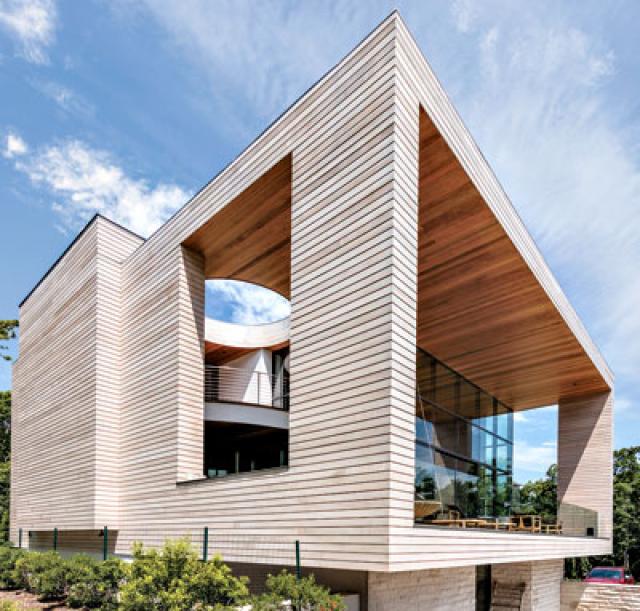Views in a Two-Story Frame

Why do people put frames around art? Aestheticians probably have Freudian answers, but obviously it has something to do with heightening the effect. Now the local architects Robert Barnes and Christopher Coy have done just that to one of the finest views in Amagansett, the vista from the top of the ridge that rises just as Route 27 leaves Amagansett for Montauk. The deep, rectangular frame that makes up the entire oceanfront side of the new house is a full two stories high. It puts wide edges around a prospect that stretches away from the house down the hill, across a field of recently planted shrubs, over the trees of Beach Hampton, and all the way to the wide Atlantic. The frame is, in fact, the edges of the walls, ceiling, and floor of a tall, completely glass-fronted living room and dining area. Through large, supposedly hurricane-proof sliding doors, one can walk through the frame almost like Alice through the looking glass. The floor then becomes a deck that looks down one story onto a swimming pool and outdoor lounge area. At the sides, the frame is punctured by huge rectangular openings that admit lesser views of nearby trees. At first, there seem to be no railings to keep you from falling right into the scene (or the pool). But then (acrophobes take heart) one notices that waist-high panels of thick, almost invisible glass stand at the edge of the deck. The house is one of the first to be built on land opposite the grand hilltop chateaus of the Devon Colony, constructed around 1910. The design has architectural roots in the brise soliel features of Le Corbusier, the early modernist architect who, Mr. Barnes avers, “has had more influence on 20th century architecture than anyone else.” Corbusier-influenced overhangs are commonplace in warm climates where shade is essential. Locally, they were used in the dramatic houses that Charles Gwathmey, with whom Mr. Coy onceworked, built on Bluff Road in Amagansett for his parents and on the oceanfront nearby. Barnes and Coy have deployed frame shapes elsewhere, but this use probably is their most dramatic, because when the house is viewed from outside, the floor seems to float in space, an effect achieved by cantilevering the frame several yards out from its foundation. Rising at least 50 feet above sea level (but conforming to town height limits by having its basement tucked into the ridge), the house has a flat roof, surrounded by more clear glass railings to enhance a nearly 360-degree view, which includes at least some of Gardiner’s Bay. (Trees block the rest.) The 6,000-square-foot house was built for George Fontini, a retired jeans manufacturer who was early to catch the bell-bottom wave and succeeded again with the luxury sportswear brand Paper, Denim, and Cloth. He and his wife, Sharon, raised their children in a traditional, center-hall brick colonial. They were persuaded to go modern, however, by Mr. Barnes’s observation that on this location, the limited windows of a more-traditional house “wouldn’t have taken advantage of the site or the view.” The international style he and Mr. Coy favor lets the house easily join a trend to “create ambiguity between the inside and outside, making the site a sort of outdoor room,” he said. The frame, clad in cedar planks that continue inside, ends at a wall of Alabama limestone, part of which forms the back of the living room and dining area. Behind this lurks a second “thickness” of the house, with, on the main floor, a family area adjacent to a large kitchen, and a maid’s or guest room. Upstairs, the house provides bedrooms for the Fontinis’ two children and a master bedroom suite. The house might well have been quite severe. Its basic rectangles embody “a very Cartesian, abstract shape,” Mr. Barnes said. But with a twinkle, he added, “all this rectilinear stuff has to have a little divergence or it looks very commercial.” The most notable divergence is a generous, half-circular balcony that extends into the living room from the second floor. Accessed from the master suite, half of it (a quarter-circle’s worth) is a ceiling-less study, with a desk positioned to take in the view. The other quarter is open to the outside air and illuminated by a round opening in the top of the frame. Below is a sheltered outdoor dining area, created because the glassed-in living room does not run the full width of the house. Another warming touch is the limestone, used inside and out. It could have been stucco, Mr. Barnes said, but the owner opted for the more elegant material. Additionally, the cedar siding will weather to gray like the cedar shingles of traditional Hamptons houses. Inside, wood is a dramatic part of the furnishings, which were chosen with help from the decorator, Julia Roth. A huge, dark walnut dining table is illuminated by 34 tiny, twinkling lights that hang underneath the balcony. Like the frame itself, the bedroom walls “float,” never seeming to touch the floors or ceilings because of 3/8-inch indented grooves (“reveals”) in the place of baseboards or molding. (The architects were full of praise for the work of the contractor, Robert Plumb, from Salt Construction.) The rectangular theme is echoed by an unusual, 10-foot-long fireplace with no hearth that is low in the wall of the living room. This summer is the Fontini family’s first in the house (they winter in Florida), so it is early for them to know how it will work for entertaining — or star gazing. Already, though, they said the view was terrific on Aug. 10, the night of the perigee moon. After all, the spectacle was nicely framed.
